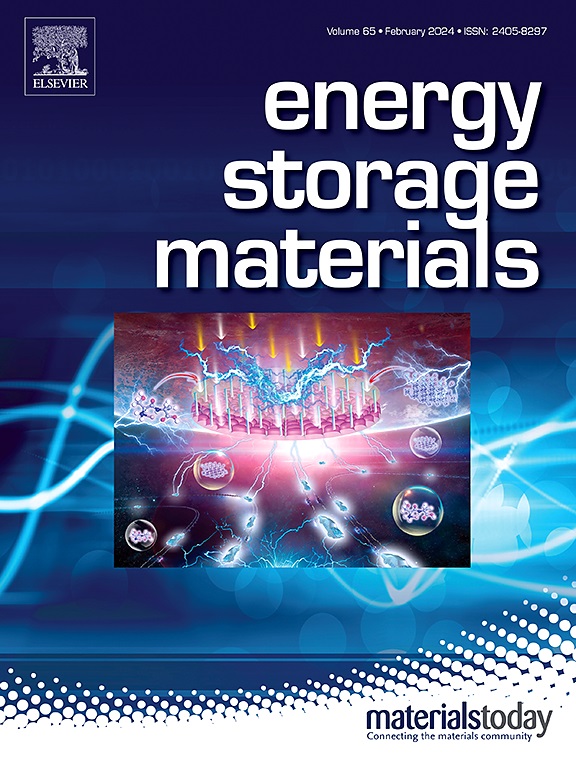O3- vs P2-type Nax(Ni,Zn,Mn,Ti)O2 layered oxides: Comparative study on electrode-electrolyte reactivity and structural stability for cycling performance
IF 20.2
1区 材料科学
Q1 CHEMISTRY, PHYSICAL
引用次数: 0
Abstract
Sodium layered oxides, having either O3, P2 or P3 stacking, are extensively studied as low-cost cathode materials for high energy Na-ion batteries (NIBs). Previous efforts focused on the optimization of layered oxide compositions resulted in the O3-Na0.85Ni0.38Zn0.04Mn0.48Ti0.1O2 and P2-Na0.67Ni0.3Zn0.03Mn0.52Ti0.15O2 phases as potential candidates to establish prototype cylindrical 18650 cells with 120-150 Wh/kg specific cell energy. In this study, we focus particularly on the electrode-electrolyte reactivity of these phases, especially at high state of charge (∼70 % or more) and at high temperatures. Our results indicate that the end-of-charge phase, O1 and O2 formed during complete de-sodiation of O3 and P2, respectively, plays a major role in determining their reactivity. The O1 phase is particularly prone to transition metal migration and oxygen oxidation, having increased reactivity with electrolyte. On the other hand, the P2 layered oxide, while having lower capacity than O3, offers better cycling stability (90 % retention after 1000 cycles at 25 °C) due to the greater stability of the O2 end-of-charge structure. These results once again underline the fact that specific capacity should not be the sole metric for determining the most suitable electrode materials for Na-ion or other battery chemistries.
O3-与p2型Nax(Ni,Zn,Mn,Ti)O2层状氧化物:电极-电解质反应性和循环性能结构稳定性的比较研究
具有O3、P2或P3堆叠的钠层状氧化物作为低成本的高能钠离子电池正极材料得到了广泛的研究。之前的研究主要集中在层状氧化物组成的优化上,结果表明O3-Na0.85Ni0.38Zn0.04Mn0.48Ti0.1O2相和P2-Na0.67Ni0.3Zn0.03Mn0.52Ti0.15O2相是建立具有120-150 Wh/kg比电池能量的圆柱形18650原型电池的潜在候选相。在这项研究中,我们特别关注这些相的电极-电解质反应性,特别是在高电荷状态(~ 70%或更多)和高温下。结果表明,O3和P2完全脱钠过程中形成的电荷末相O1和O2是决定其反应活性的主要因素。O1相特别容易发生过渡金属迁移和氧氧化,与电解质的反应性增加。另一方面,P2层状氧化物虽然容量低于O3,但由于O2电荷端结构的稳定性更高,因此具有更好的循环稳定性(在25°C下循环1000次后保持90%)。这些结果再次强调了一个事实,即比容量不应该是决定最适合钠离子或其他电池化学物质的电极材料的唯一指标。
本文章由计算机程序翻译,如有差异,请以英文原文为准。
求助全文
约1分钟内获得全文
求助全文
来源期刊

Energy Storage Materials
Materials Science-General Materials Science
CiteScore
33.00
自引率
5.90%
发文量
652
审稿时长
27 days
期刊介绍:
Energy Storage Materials is a global interdisciplinary journal dedicated to sharing scientific and technological advancements in materials and devices for advanced energy storage and related energy conversion, such as in metal-O2 batteries. The journal features comprehensive research articles, including full papers and short communications, as well as authoritative feature articles and reviews by leading experts in the field.
Energy Storage Materials covers a wide range of topics, including the synthesis, fabrication, structure, properties, performance, and technological applications of energy storage materials. Additionally, the journal explores strategies, policies, and developments in the field of energy storage materials and devices for sustainable energy.
Published papers are selected based on their scientific and technological significance, their ability to provide valuable new knowledge, and their relevance to the international research community.
 求助内容:
求助内容: 应助结果提醒方式:
应助结果提醒方式:


